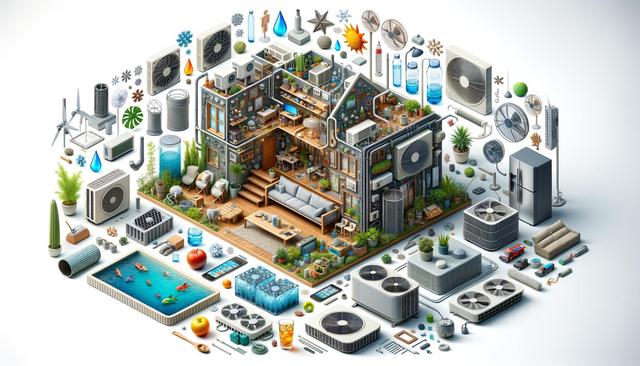
Staying Cool at Home: A Guide to Home Cooling Systems
Understanding the Basics of Home Cooling Systems
Home cooling systems are designed to regulate indoor temperature and improve air quality, particularly during hot seasons. They vary in design, functionality, and energy consumption. The most common types include central air conditioning, ductless mini-split systems, window units, and evaporative coolers. Each system has its own advantages depending on the size of the home, regional climate, and budget.
Central air conditioning systems are often preferred for larger homes due to their ability to cool multiple rooms evenly. These systems use ducts to distribute cool air throughout the house. Ductless mini-split systems, on the other hand, are ideal for homes without ductwork. They consist of an outdoor compressor and one or more indoor units, offering zoned cooling and energy efficiency.
Window units are an accessible option for cooling individual rooms. They are relatively easy to install and can be removed when not in use. Evaporative coolers, also known as swamp coolers, are suitable for dry climates and use water to cool air, making them energy-efficient and environmentally friendly. Understanding these options helps in choosing a system that aligns with specific needs and conditions.
Factors to Consider When Choosing a Cooling System
Selecting the right cooling system involves evaluating several factors to ensure optimal performance and energy efficiency. One key consideration is the size of the space to be cooled. A system that’s too small will struggle to maintain a comfortable temperature, while an oversized system can lead to higher energy bills and unnecessary wear and tear.
Other important factors include:
- Energy efficiency ratings, such as SEER (Seasonal Energy Efficiency Ratio)
- Initial installation and long-term maintenance costs
- Compatibility with existing home infrastructure
- Climate and humidity levels in the area
- Noise levels and placement of units
Consulting with a licensed HVAC professional can provide valuable insights into the most suitable system for your home. They can also assist with load calculations and offer recommendations based on current energy standards.
Energy Efficiency and Cost Savings
Improving energy efficiency is a key benefit of modern home cooling systems. Many newer models are designed to consume less electricity while delivering consistent performance. Investing in an energy-efficient system can significantly reduce utility bills over time, especially in regions with long, hot summers.
Ways to enhance energy efficiency include:
- Installing a programmable thermostat to manage cooling schedules
- Regular maintenance, such as cleaning filters and checking refrigerant levels
- Sealing windows and doors to prevent cool air from escaping
- Using ceiling fans to circulate air and reduce demand on the cooling system
Energy-efficient systems may also qualify for government rebates or incentives, offering additional savings. Choosing appliances with an ENERGY STAR rating is a practical step toward both environmental responsibility and economic benefit.
Maintenance and Longevity of Cooling Systems
Regular maintenance plays a vital role in extending the lifespan of home cooling systems. Routine checks and timely servicing can prevent minor issues from escalating into costly repairs. Most manufacturers recommend annual inspections by certified technicians to ensure the system operates at peak efficiency.
Key maintenance tasks include:
- Cleaning or replacing air filters every 1–3 months
- Checking for leaks in ductwork or refrigerant lines
- Inspecting thermostats and electrical connections
- Clearing debris from outdoor units to maintain airflow
Neglecting these steps can lead to reduced efficiency, higher energy consumption, and a shorter system lifespan. Homeowners should also be aware of the signs that a system may need replacement, such as frequent breakdowns, inconsistent temperatures, or unusually high energy bills. Investing in maintenance not only ensures comfort but also protects the value of the system over time.
Integrating Cooling Systems with Smart Home Technology
Modern home cooling systems can be enhanced with smart home technologies, offering greater control and efficiency. Smart thermostats, for example, allow users to monitor and adjust temperature settings remotely via smartphone apps. These devices can learn user preferences and automatically optimize cooling schedules to reduce energy use.
Additional smart features include:
- Voice control integration with home assistants
- Real-time energy usage tracking
- Maintenance alerts and diagnostic tools
- Zoned cooling for targeted temperature control in different areas
Integrating cooling systems with smart home platforms provides not only convenience but also valuable data that can inform future upgrades or adjustments. For households aiming to reduce their carbon footprint or improve indoor comfort, smart technology offers a forward-thinking solution.
Conclusion: Making an Informed Cooling Choice
Choosing the right home cooling system is a significant decision that impacts comfort, energy use, and long-term costs. By understanding the different types of systems, evaluating your specific needs, and considering energy efficiency and maintenance strategies, you can make a well-informed choice. Whether upgrading an existing system or installing a new one, taking the time to research options and consult professionals can lead to a more comfortable and cost-effective home environment. For those interested in smart technology, integrating advanced controls can further enhance the cooling experience while promoting sustainability.